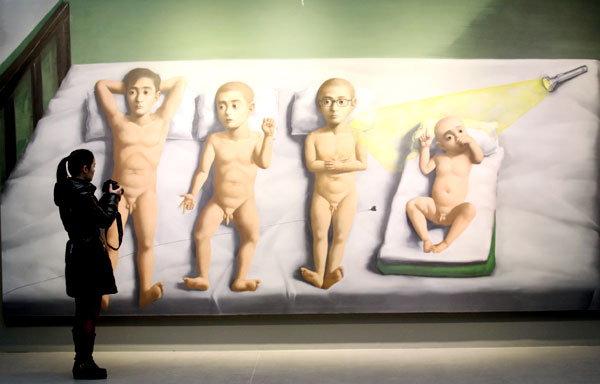
 |
|
Highlights of Zhang's show include My Father (above) and Afternoon No 2 (top). Provided to China Daily |
Since the start of his very successful Bloodline - Big Family series in the mid-1990s, Zhang has witnessed and experienced a particular history of China.
"Zhang is a conservative artist. His art originates from the past and emphasizes one's interrelationship with the past, which takes us back to a world with roots, warmth and emotional tension," observes Leng Lin, chief executive of Pace Gallery Beijing and curator of the exhibition.
"To some extent," Zhang confesses, "I am a pessimist, and I don't believe in the future.
Adding that the arch-criminal is rapid change, he says that "looking back makes me dependable".
As a result, symbols that represent the past, such as the light bulb and the flashlight, recur in his new works. Several of his works feature the plum blossom, a symbol he has embraced since 2009.
The painter found that in the published volumes of the Song Dynasty (960-1279), plum blossoms painted by the emperors have a sense of loneliness. But in the revolutionary age, the plum blossom evolved into the embodiment of the revolutionist.
Related: Joys of online shopping not just for the young
Both meanings have influenced Zhang. From his modern point of view, the plum blossom becomes the magnification of bonsai, which indicates family.
"When something has to be said, it becomes a language itself," says the artist, adding he is not into creating a literal record but capturing the wish for memory.
"The memory has been rewritten all the time. I'm not a historian, so authenticity is not important to me at all," he says.
The work Father and Son combines his childhood memory as a son and his present life as a father to his daughter. In this way he "makes time travel, convert and create a new space".
He also puts completely irrelevant objects together to create a sense of absurdity and misplacement.
He lets the plum branches lie on a bed, for instance, or mixes the plum blossom with medicine bottles.
"Zhang Xiaogang's 'amnesia' is the space of creative play where past and present, remembering and forgetting, the 'me' and 'not me' come together," US art historian and art critic Jonathan Fineberg writes in the article The Space of Amnesia: Zhang Xiaogang's New Work.
|
|
|